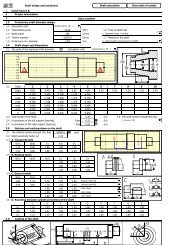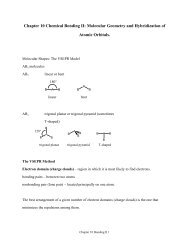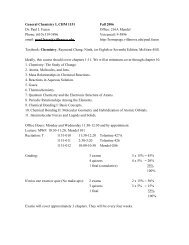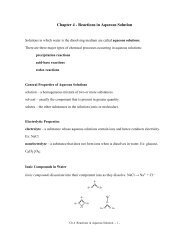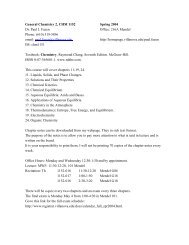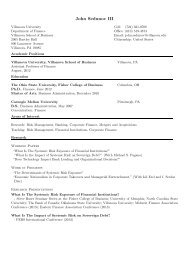A Culture of Collaborative Inquiry: Learning to Develop and Support ...
A Culture of Collaborative Inquiry: Learning to Develop and Support ...
A Culture of Collaborative Inquiry: Learning to Develop and Support ...
You also want an ePaper? Increase the reach of your titles
YUMPU automatically turns print PDFs into web optimized ePapers that Google loves.
Figure 1, adapted from Cohen <strong>and</strong> Ball (1999), Cohen,Raudenbush, <strong>and</strong> Ball , <strong>and</strong> Carroll, Moretti, <strong>and</strong> Mumme (2005),portrays the model used <strong>to</strong> describe the interactions amongclassroom practices, teacher inquiry, context, facilitation, <strong>and</strong>pr<strong>of</strong>essional development. As depicted in the ―second circle‖ <strong>of</strong>this graphic, the focus <strong>of</strong> the teachers‘ discussions was some aspect<strong>of</strong> high-quality teaching <strong>and</strong> learning, as manifested across theirclassrooms. Over time, through dialogic <strong>and</strong> data-driven processes,an inquiry focus emerged. Because some members <strong>of</strong> each PLCduring Year 1 came from a different context (middle or highschool, mathematics or science), negotiation arose naturally overelements <strong>of</strong> teaching <strong>and</strong> student learning, including those thatmight be <strong>of</strong> common interest <strong>and</strong> significance <strong>to</strong> all. Similaractivity occurred at the school-based level after Year 1, with thelead teacher moving <strong>to</strong>ward the facilitation role in the PLC.One key aspect <strong>of</strong> project structure, planned from the project‘sinception, was the facilitation <strong>of</strong> the teacher PLCs by a member <strong>of</strong>the SC (identified as ―leader‖ in the second circle <strong>of</strong> Figure 1).Facilitation was constructive, not directive; project staff wereintentional in supporting the teachers‘ ability <strong>to</strong> make decisionsabout their inquiry work. Specifically, in addition <strong>to</strong> providinglogistical support for organizational <strong>and</strong> meeting details,facilita<strong>to</strong>rs supported teachers in surfacing <strong>and</strong> negotiating beliefs<strong>and</strong> engaging in an inquiry cycle consisting <strong>of</strong> the development <strong>of</strong>an inquiry focus <strong>and</strong> design, data collection <strong>and</strong> analysis, <strong>and</strong>synthesis (Nelson & Slavit, 2007). Three sets <strong>of</strong> facilita<strong>to</strong>rs weredesignated <strong>to</strong> support all PLCs in one large suburban district, onemedium-sized suburban district, <strong>and</strong> among the teachers in foursmaller rural districts.All facilita<strong>to</strong>rs were members <strong>of</strong> the SC. The SC was ultimatelycomposed <strong>of</strong> district-level mathematics <strong>and</strong> science specialists,current or former middle school teachers, <strong>and</strong> universitymathematics <strong>and</strong> science educa<strong>to</strong>rs. Descriptions <strong>of</strong> the individualmembers <strong>of</strong> the SC, as well as its formation <strong>and</strong> evolution, areprovided in subsequent sections. Occasionally, two different highschool principals participated on the committee, but thisinvolvement was not sustained. Like the teacher participants, eachmember <strong>of</strong> the SC had other full-time responsibilities in addition <strong>to</strong>PRiSSM. The overall planning <strong>of</strong> the SC meetings was conductedby a four-person leadership team (described later), but thefacilitation <strong>of</strong> the SC‘s PLC inquiry rotated among its members.As seen in the outer circle <strong>of</strong> Figure 1, the SC members met<strong>to</strong>gether <strong>to</strong> explore the focus <strong>of</strong> our own inquiry: facilitating thework <strong>of</strong> the lead teacher PLCs. In essence, although the teachersparticipated in collaborative inquiry on their own practice, we also<strong>to</strong>ok a collaborative approach <strong>to</strong> underst<strong>and</strong>ing our pr<strong>of</strong>essionaldevelopment practices related <strong>to</strong> the support <strong>of</strong> the teachers.As stated above, PRiSSM was not designed <strong>to</strong> assist teachers inimplementing a specific curriculum or instructional technique, norwas it specifically focused on the development <strong>of</strong> contentknowledge. Rather, PRiSSM was designed <strong>to</strong> support teachers inframing questions about their practice, <strong>and</strong> then provide the time,intellectual, <strong>and</strong> material resources <strong>to</strong> support a collaborative,action research approach <strong>to</strong> these questions. In some sense,PRiSSM can be thought <strong>of</strong> as constructivist pr<strong>of</strong>essionaldevelopment in which the teachers helped guide <strong>and</strong> control thecontent <strong>and</strong> direction <strong>of</strong> their learning in small groups, supportedby a facilita<strong>to</strong>r (Stein et al., 1999). But like a teacher who responds<strong>to</strong> an array <strong>of</strong> student ideas in a lesson, the SC met significantchallenges in developing <strong>and</strong> maintaining project structure <strong>and</strong>coherence while providing support <strong>to</strong> the wide array <strong>of</strong> inquiry foci<strong>and</strong> approaches that emerged. Lisa, a member <strong>of</strong> the SC, voiced theuncertainties felt by many at the beginning <strong>of</strong> the project‘s secondyear: ―In the very beginning I was very concerned about how wewould do our work, there wasn‘t really a plan <strong>of</strong> how it would go,so it was learning by doing. . . . Gosh, we‘re still so much in the4 | P a g e




